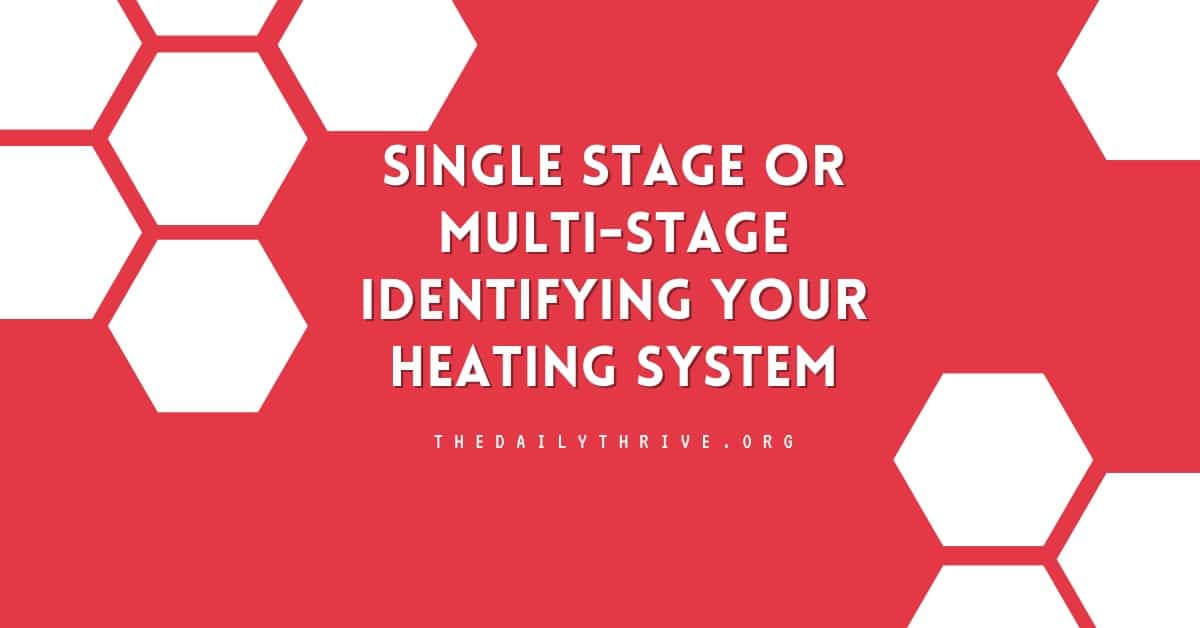Determining whether you have a single-stage or multi-stage heating system is crucial for understanding how your home is heated and how you can maximize energy efficiency during the colder months. This knowledge helps ensure your comfort and plays a significant role in managing your heating costs effectively. Let’s dive into how you can identify the type of heating system you have and understand its implications for your home’s heating.
A single-stage heating system operates on a simple principle: either on at full capacity or completely off. This system doesn’t adjust to the temperature outside or your home’s heating needs beyond the binary choice.
In contrast, a multi-stage heating system, including two-stage or variable-speed furnaces, can adjust its output based on the current heating demand. This flexibility provides gentle, consistent warmth, reducing temperature swings and improving comfort.
By recognizing the difference between single-stage and multi-stage heating systems, you can decide which is best for your home. Luckily, there are several ways to distinguish between them, and I’d be happy to share some tips with you so you can choose the right HVAC system for your needs.
Step 1: Check The Thermostat
Your thermostat is the first place to look to determine the complexity of your heating system.
Modern thermostats, especially those designed to control multi-stage systems, will have settings for various heating stages, such as “low,” “medium,” “high,” or “auxiliary heat.” If your thermostat only allows you to turn the heat on or off without these options, you likely have a single-stage system.
Step 2: Check The Furnace Model Number
Your furnace’s model number is a gateway to a wealth of information about your system.
You can typically find this furnace model number in the product manual, on the front, or inside the front panel. This alphanumeric code can tell you not just about the type of furnace you have but also its efficiency, capacity, and more.
Step 3: Online Research
Once you have your furnace’s make and model number, a quick internet search can reveal its specifications. Manufacturer websites and HVAC forums are great resources for this information. Product description pages often list whether a furnace is single-stage or multi-stage, providing a clear answer to your question.
Benefits of Multi-Stage Heating Systems
Multi-stage HVAC systems are revolutionizing our thoughts about heating, cooling, and indoor comfort. Here are the top ten advantages of integrating one into your home space.
1. Reduced HVAC Energy Usage
Multi-stage systems excel in energy efficiency. Operating primarily in a lower setting, these units distribute air precisely and efficiently, minimizing the need for high-power, high-cost operations. Unlike traditional systems that frequently turn on and off, consuming considerable energy, variable-speed compressors run continuously at lower capacities, significantly cutting down energy use.
2. Enhanced System Effectiveness
The ability to fine-tune airflow to the exact requirements of the ductwork means multi-stage systems are more adept at meeting specific zone needs with minimal energy waste. This adaptability ensures your space is always comfortable without the excessive energy of single- or two-stage systems.
3. Improved Performance
By limiting operation to lower stages unless higher heating or cooling is necessary, these systems minimize energy waste, enhance humidity control, and improve overall comfort. The equipment’s lower capacity levels during less demanding periods contribute to a more efficient, effective heating and cooling process.
4. Customizable Operation
Multi-stage systems offer HVAC professionals the flexibility to tailor staging settings to the unique demands of different zones, considering factors such as size, insulation, and occupancy. This precision ensures that each area receives the appropriate amount of heating or cooling, enhancing comfort and efficiency.
5. Superior Dehumidification
Operating at a lower capacity for extended periods, these systems remove moisture from the air and maintain comfortable humidity levels. This continuous operation helps prevent the growth of mold and mildew, contributing to healthier indoor air quality.
6. Elimination of Energy-Wasting Bypass Operation
By basing CFM staging on zone weight rather than temperature, multi-stage systems provide the precise control necessary to avoid unnecessary high-stage air delivery. This strategic operation eliminates the need for energy-wasting bypasses during high-stage blower operations.
7. Enhanced Comfort
The tailored airflow and precise temperature control offered by multi-stage equipment mean fewer temperature fluctuations and humidity swings, contributing to a consistently comfortable environment. Additionally, the reduced need for high-capacity operation results in quieter system performance, further adding to the comfort of your space.
8. Intelligent Energy Management
Many multi-stage systems are compatible with programmable thermostats, allowing for advanced temperature control based on occupancy patterns. This feature optimizes comfort and contributes to smarter energy use, potentially lowering utility bills and easing the strain on the electrical grid during peak times.
9. Optimal Register Velocity
The careful management of blower speeds ensures efficient delivery of conditioned air, minimizing drafts and temperature stratification. This thoughtful design keeps air velocity through registers at optimal levels, ensuring efficient, comfortable airflow throughout the space.
10. A Comprehensive Solution
Multi-stage, variable-speed HVAC systems address common comfort and energy challenges by offering customized solutions for diverse spaces. Adjusting to each zone’s specific needs provides precise temperature control, improved energy efficiency, and enhanced comfort, resulting in lower operating costs and superior indoor air quality.
Knowing When to Upgrade to Multi-Stage
If you currently have a single-stage heating system and live in an area with harsh winters, you might consider upgrading to a multi-stage system for improved comfort and efficiency.
Single-stage systems might suit homes in milder climates or homeowners prioritizing upfront cost savings. On the other hand, two-stage systems are ideal for those living in areas with wide temperature swings or for anyone seeking to optimize their home’s energy efficiency and comfort levels.
Our recommendation for the best heating system is as follows:
Before deciding, consider consulting with a heating and cooling professional who can assess your home’s specific needs and recommend the most suitable type of heating system. Investing in the right heating system can ensure your comfort during the colder months and contribute to long-term savings on your energy bills.
Identifying whether you have a single-stage or multi-stage heating system is essential for homeowners looking to understand and optimize their home heating. By following the steps outlined—examining your thermostat, finding your furnace model number, conducting online research, and consulting DOE resources—you can easily determine the type of system you have. Remember, consulting with a professional HVAC technician can provide clarity and guidance when in doubt about interpreting information about your heating system.






